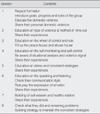Abstract
Purpose
The purpose of this study was to evaluate the contribution of group therapy to the improvement of self-esteem, anger, stress coping and communication of those who were violent in to family.
Methods
The research design was a one-group-pretest-posttest design in quasi-experimental research, and the period of this study was from March to October, 2005. Participants were 14 offenders who were ordered to be counseled according to 'the special exemption law for punishing domestic violence.' Group therapy was applied once a week for 8 weeks. Results were collected by using a questionnaire for self-esteem, anger, stress coping and communication. In the data analysis, Wilcoxon signed test with SPSS/WIN 12.0 program was used.
Figures and Tables
References
1. Bellavial G, Murray S. Did I do that? Self-esteem related differences in reactions to romantic partner's moods. Personal Relationship. 2003. 10:77–95.
2. Chang HS, Kim YS. A typology of marital violent men: Testing the three batterer subtypes derived from theory. Korean Journal of Social Welfare. 2004. 56:303–325.
3. Choi HR. A study on college students self-esteem, depression and family self. Korean Journal of Counseling Psychotherapy. 1999. 11:183–197.
4. Choi SL. A study on the application of cognitive behavioral model to reduce abusing behavior of Korean wife abusers. Korean Journal of Family Social Work. 2001. 7:275–311.
5. Chun BJ. Self-esteem: A test of its measurability. Yonsei Study. 1974. 10:109–129.
6. Dutton DG. Intimate abusivenss. Clinical Psychology. 1995. 2:207–224.
7. Edelson JL, Tolman RM. Intervening for men who batter: An ecological approach. 1992. Newbury Park: Sage publications.
8. Edelson JL, Tolman RM. Treating men who batter: Theory, practice and programs. 1994. New York: Springer Pub. Co..
9. Holtzworth-Munroe A, Stuart GL. Typologies of male batterers: Three subtypes and the differences among them. Psychological Bulletin. 1994. 116:476–497.

10. Jung SY. Study about factors affecting domestic violence -Centering around home environment and stress-. 1997. Suwon: Kyonggi University;Unpublished master's thesis.
11. Kim DS, Kim JO, Song JA. The relationship between marital communication style and marital violence. Korean Home Management Association. 2000. 18:1–16.
12. Kim JO, Jeon HM, Lee HH. The effects of self-esteem, marital communication and cohesion on the wife abuse. Journal of the Women's Problem Research Institute. 1992. 20:21–44.
13. Kim JY, Choi SJ. Why does wife-assault occur?: An integrated model study for influences of social and psychological factors on wife-assault of husband. Korean Journal of Society & Personal Psychology. 2004. 18:77–95.
14. Kim KS, Kim JR. Analysis on the effectiveness of domestic violence offenders intervention program. Journal of Family Relations. 2002. 7:137–158.
15. Kim MY. Effects of group intervention programs for the offenders of family violence. The Korean Journal of Counseling and Psychotherapy. 2006. 18:519–546.
16. Kim SI. Relations of family violence, gender role socialization, and school violence. Korean Journal of Youth Studies. 2005. 12:215–241.
17. Kwon JS, Chun SK. A study on the group intervention for family violent offenders. Korean Journal of Social Welfare. 2001. 3:36–63.
18. Lee JE, Park HR. Body-related attitude, self-esteem and eating attitude in undergraduate students. Journal of Korean Academy of Psychiatric and Mental Health Nursing. 2003. 12:603–611.
19. Lee JS. Effects of Batterer treatment program on relapse prevention. 2004. Daejeon: Daejeon University;Unpublished master's thesis.
20. Lee SW. A study for development of batterer treatment program of domestic violence and its effectiveness. 2003. Seoul: Yonsei University;Unpublished master's thesis.
21. Maiuro RD, Cahn TS, Vitaliano PP. Assertiveness deficits and hostility in domestically violent men. Violence and Victims. 1986. 1:279–289.

22. Mathews DJ. Group counselling for family violent offenders. 2000. Seoul: Nanumchulpasa.
23. Murphy CM, Baxter VA. Motivating batterers to change in the treatment context. Journal of Interpersonal Violence. 1997. 12:607–618.

24. Rosenberg M. Society and adolescent self-image. 1965. Princeton, NJ: Princeton University Press.
25. Satir V, Baldwin M. Satir step by step: A guide to creating change in families. 1983. Palo Alto: Science and Behavior Book, Inc..
26. Saunders DG, Lynch AB, Grayson M, Linz D. The inventory of beliefs about wife beating: The construction and initial validation of a measure of beliefs and attitudes. Violence and Victims. 1987. 2:39–57.

27. Seo HS. The study on the effect of marital group counseling program to improve the self-esteem and a marital couples enhancing of domestic family violence - Centered on V. Satir's theory of growth model-. Korean Journal of Family Welfare. 2005. 10:25–41.
28. Shin BM. Effects of group intervention programs for the offenders of family violence. -Centering of conflict coping and dysfunctional communication-. 2005. Daejeon: Daejeon University;Unpublished master's thesis.
29. Spielberger CD, Jacobs GA, Russell S, Crane RS. Assessment of anger: The state-trait anger scale. Advanced Personal Assessment. 1983. 2:159–187.
30. Stith S, Rosen K, Middleton K, Busch A, Lundeberg K, Carlton R. The intergenerational transmission of spouse abuse: A meta-analysis. Journal of Marriage and the Family. 2000. 62:640–654.

31. Sung JH, Jung MJ. The family counselling education program for family violence assailant. Journal of Human Ecology. 2002. 3(2):23–42.
32. Wallace D, Seymour A. Coleman G, Gaboury M, Murray M, Seymour A, editors. Domestic violence. 1999 National Victim Assistance Academy. 2001. Washington, D.C.: U.S. Department of justice;98–112.
33. Wolfe D, Jaffe P. Child abuse and family violence as determinants of child psychopathology. Canadian Journal of Behavioral Science. 1991. 23:282–299.

34. Yeon SJ. Attitudes toward violence among Koreans. 2000. Seoul: Korean Institute of Criminology.
35. Yoo TS. A study on characteristics of domestic violence. 2003. Seoul: Kyunghee University;Unpublished master's thesis.




 PDF
PDF ePub
ePub Citation
Citation Print
Print





 XML Download
XML Download